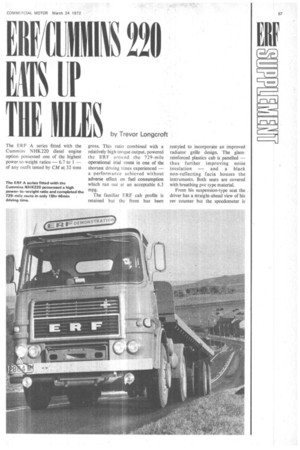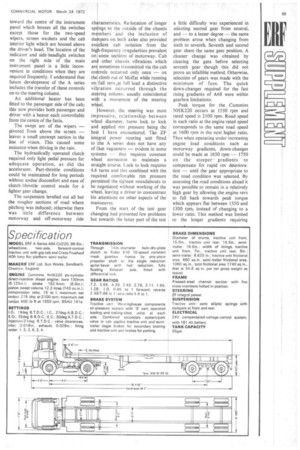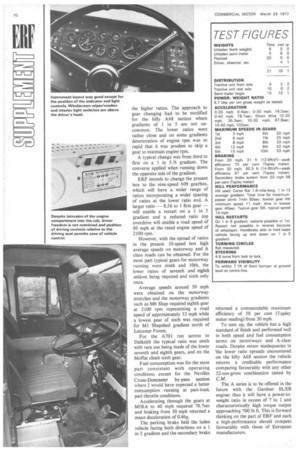MANS 220 EATS FP
Page 69

Page 71

Page 72

If you've noticed an error in this article please click here to report it so we can fix it.
THE MILES by Trevor Longer-oft
The ERE A series fitted with the Cummins NHK220 diesel engine option possessed one of the highest power-to-weight ratios — 6.7 to 1 of any outfit tested by CM at 32 tons gross. This ratio combined with a relatively high torque output, powered the ERF around the 729-mile operational trial route in one of the shortest driving times experienced a performance achieved without adverse effect on fuel consumption which ran out at an acceptable 6.3 mpg.
The familiar ERE cab profile is retained but the front has been restyled to incorporate an improved radiator grille design. The glass reinforced plastics cab is panelled thus further improving noise insulation -and a black non-reflecting facia houses the instruments. Both seats are covered with breathing pvc type material.
From his suspension-type seat the driver has a straight-ahead view of his rev 'counter but the speedometer is toward the centre of the instrument panel which houses all the switches except those for the two-speed wipers, screen washers and the cab interior light which are housed above the driver's head. The location of the indicator and side-headlight switches on the right side of the main instrument panel is a little inconvenient in conditions when they are required frequently. I understand that future development of the A series includes the transfer of these controls on to the steering column.
An additional heater has been fitted to the passenger side of the cab; this now provides both passenger and driver with a heater each controllable from the centre of the facia.
The swept arc of the wipers — pivoted from above the screen — leaves a small unswept section in the tine of vision. This caused some nuisance when driving in the rain.
The hydraulically operated clutch required only light pedal pressure for adequate operation, as did the accelerator. Part-throttle conditions could be maintained for long periods without undue discomfort and ease of clutch /throttle control made for a lighter gear change.
The suspension levelled out all but the rougher sections of road where pitching was induced; otherwise there was little difference between motorway and off-motorway ride
ch racteristics, Re-location of longer sp 'ngs to the outside of the chassis m mbers and the inclusion of da pers on both axles also provided ex ellent cab isolation from the hi -frequency irregularities prevalent on some sections of motorway. Cab an other chassis vibrations which ar sometimes transmitted via the cab Co trols occurred only once — on the climb out of Moffat while running on full revs at full load a distinctive vi ration occurred through the ste ring column, usually coincidental wi a movement of the steering wh I.
owever, the steering was most impressive, relationship between wheel diameter, turns lock to lock an applied rim pressure being the be t I have encountered. The ZF int gral power steering unit fitted to the A series does not have any of hat vagueness — evident in some systems -that requires constant wheel correction to maintain a straight course. Lock to lock requires 4.6 turns and this combined with the required comfortable rim pressure permitted the tightest roundabouts to be negotiated without working of the wheel, leaving a driver to concentrate his attentions on other aspects of the manoeuvre.
From the start of the test gear changing had presented few problems but towards the latter part of the test a little difficulty was experienced in selecting second gear from neutral, and — to a lesser degree — the same problem arose when changing from sixth to seventh. Seventh and second gear share the same gate position. A cleaner change was obtained by clearing the gate before selecting seventh gear though this did not prove an infallible method. Otherwise, selectiOn of gears was made with the minirrium of fuss. The quick down-changes required for the fast rising gradients of A68 were within gearbox limitations.
Peak torque for the Cummins NHK220 occurs at 1550 rpm and rated speed is 2100 rpm. Road speed in each ratio at the engine rated speed corresponds to the same road speed at 1600 rpm in the next higher ratio. Thus when operating under increasing engine load conditions such as motorway gradients, down-changes could be made at 1650 rpm — 1750 on the steeper .gradients to compensate for rapid rev deterioration — until the gear appropriate to the road condition was selected. By assessing the road conditions ahead it was possible to remain in a relatively high gear by allowing the engine revs to fall back towards peak torque which appears flat between 1550 and 1300 rpm, instead of changing to a lower ratio. This method was limited to the longer gradients requiring the higher ratios. The approach to gear changing had to be modified for the hilly A68 section where gradients of I in 5 are not uncommon. The lower ratios were rather close and on some gradients deterioration of engine rpm was so rapid that it was prudent to skip a gear to maintain engine rpm. A typical change was from third to first on a 1 in 5 /6 gradient. The converse applied when running down the opposite side of the gradient.
ERF intends to change the present box to the nine-speed 609 gearbox, which will have a wider range of ratios incorporating a wider spacing of ratios at the lower ratio end. A larger ratio — 8.56 to 1 first gear — will enable a restart on a I in 5 gradient and a reduced ratio top overdrive will enable a road speed of 60 mph at the rated engine speed of 2100 rpm.
However, with the spread of ratios in the present 10-speed box high average speeds on motorway and A class roads can be obtained. For the most part typical gears for motorway running were ninth and 10th, the lower ratios of seventh and eighth seldom being required and sixth only once.
Average speeds around 50 mph were obtained on the motorway stretches and the motorway gradients such as M6 Shap required eighth gear at 2100 rpm representing a road speed of approximately 33 mph while a lowest gear of sixth was required for MI Shepshed gradient north of Leicester Forest.
For the A701 run across to Dalkeith the typical ratio was ninth with rare use being made of the lower seventh and eighth gears, and on the Moffat climb sixth gear.
Fuel consumption was for the most part consistent with operating conditions except for the Nevilles Cross-Doncaster by-pass section where I would have expected a better consumption running at part-load, part-throttle conditions. Accelerating through the gears at MIRA to 40 mph required 78.7sec and braking from 30 mph returned a mean deceleration of 0.46g.
The parking brake held the laden vehicle facing both directions on a 1 in 5 gradient and the secondary brake returned a commendable maximum efficiency of 58 per cent (Tapley meter reading) from 20 mph.
To sum up, the vehicle has a high standard of finish and performed well in both speed and fuel consumption terms on motorways and A-class roads. Despite minor inadequacies in 'the lower ratio spreads encountered on the hilly A68 section the vehicle returns a creditable performance comparing favourably with any other 32-ton-gross combination tested by
C.M.
The A series is to be offered in the future with the Gardner 8LXB engine: thus it will have a power-toweight ratio in excess of 7 to 1 and characteristically high torque output approaching 700 lb ft. This is forward thinking on the part of ERE and such a high-performance should compete favourably with those of European manufacturers.




















































































































































